When purchasing a car, the transmission is often one of the most critical aspects that will dictate your driving experience. It determines how power from the engine gets to the wheels, affecting how smooth, responsive, and efficient the ride feels. Although automatics have become far more prevalent, many car enthusiasts and performance fans still prefer the control and engagement of a manual transmission.
When buying a manual car, you must encounter two of the most common types: 5-speed and 6-speed manual transmissions. The difference may seem so minor at first glance, but your choice could entirely make and break everything, from fuel efficiency to acceleration and even long-term durability. Thus, should you go for the simplicity and reliability of a 5-speed manual, or opt for a 6-speed manual with one extra gear to give you a clear advantage?
In this blog post, we break it down all for you. We will explain how a transmission works, key 6 speed manual vs 5 speed differences, and what fits your driving style better.
By the end of this blog, you will know which is best for you. Let’s get started.
What Is A Transmission In A Car?
A transmission, also called a gearbox, is an essential part of your car, determining how power from the engine goes to the wheels. It controls the speed, torque, and direction using a set of gears for a smooth drive. The most common types are manual, automatic, and continuously variable transmissions (CVT). There is a transmission that requires manual shifting by the driver, which is called manual, and the other one, which does this automatically, is known as automatic.
Now, if people mention the speed of a transmission, they are referring to how many gears it contains. Take a 5-speed transmission, which has five forward gears, or a 6-speed, which has six. The higher the number of gears, the better the car can match its power according to the situation.
How Does Transmission Work?
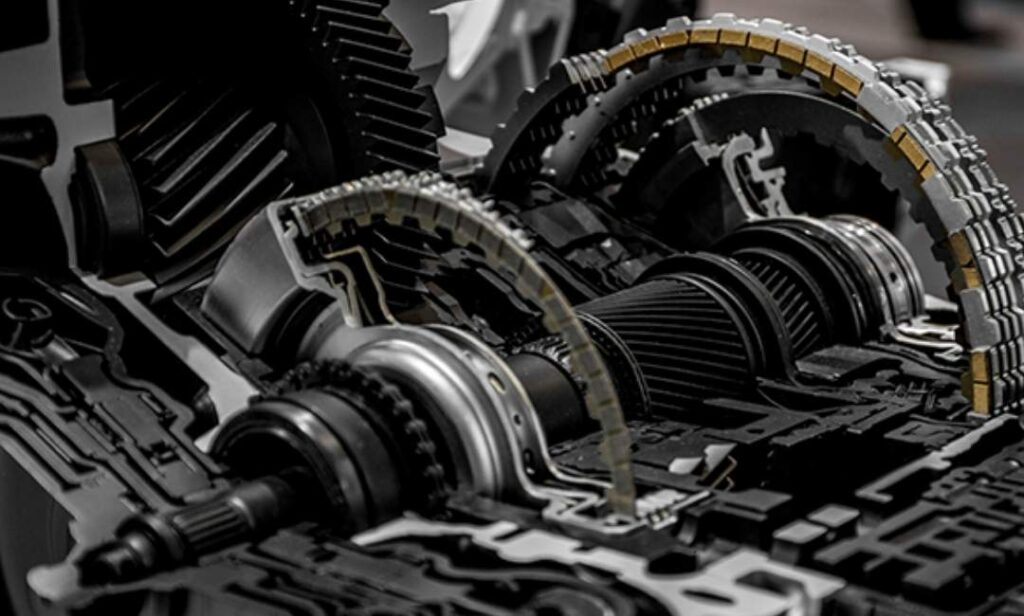
A transmission applies various gear ratios to translate engine speed into the appropriate wheel speed for propulsion. When departing a stop, the transmission engages larger, lower gears that take the engine’s high speed and turn it into more power to advance the car. The more the car picks up speed, the less amount of power is needed to sustain movement, so the transmission shifts to smaller, higher gears to maintain speed and help burn less fuel.
Electric vehicles like Tesla models are very different. Most of them are single-gear transmissions because electric motors provide enough torque to move the car without the need for multiple gears.
Types of Transmission
A car’s most important component after the engine is its transmission. Essentially, a transmission controls how to send power from the engine to the wheels of a vehicle. While it may seem like a straightforward thing, you will be surprised to know that there are more than one types of automotive transmission offering you full to partial control over your vehicle. To be able to find the right fit for yourself, it is wise you take a closer look at the different types of transmissions you can get in the market.
1. Manual Transmission
A manual transmission involves using a clutch pedal and a gear lever for the driver to shift gears. The system transfers power from the engine to the wheels through rods and gears. Though it demands more effort to be put in, it is said to have better control over the vehicle, which is why most driving enthusiasts opt for it due to its exciting feel.
2. Automatic Transmission
The automatic transmission allows for shifting gears independently and doesn’t require the driver to clutch. The modes vary depending on the vehicle, like in park (P), reverse (R), neutral (N), and drive (D), which will make it easy to operate a vehicle. In some cars with an automatic, there’s the option to shift manually by paddle shifters or gear selectors.
3. Continuously Variable Transmission (CVT)
A CVT transmission is the type that never contains fixed gears as in ordinary transmissions. It depends upon a system of pulleys and belts to give a smooth experience in driving. This increases fuel efficiency and acceleration; hence, CVTs are widely popular in modern cars, especially hybrids.
4. Dual-Clutch Transmission (DCT)
A dual-clutch transmission is a manual and automatic hybrid. It has two clutches to switch gears rapidly and a smoother transition without using a clutch pedal. This might be another reason for high acceleration and excellent fuel efficiency; hence, it is popular in sports cars and performance vehicles.
What Are The Key Differences Between 6 Speed Manual vs. 5 Speed Manual Transmissions?
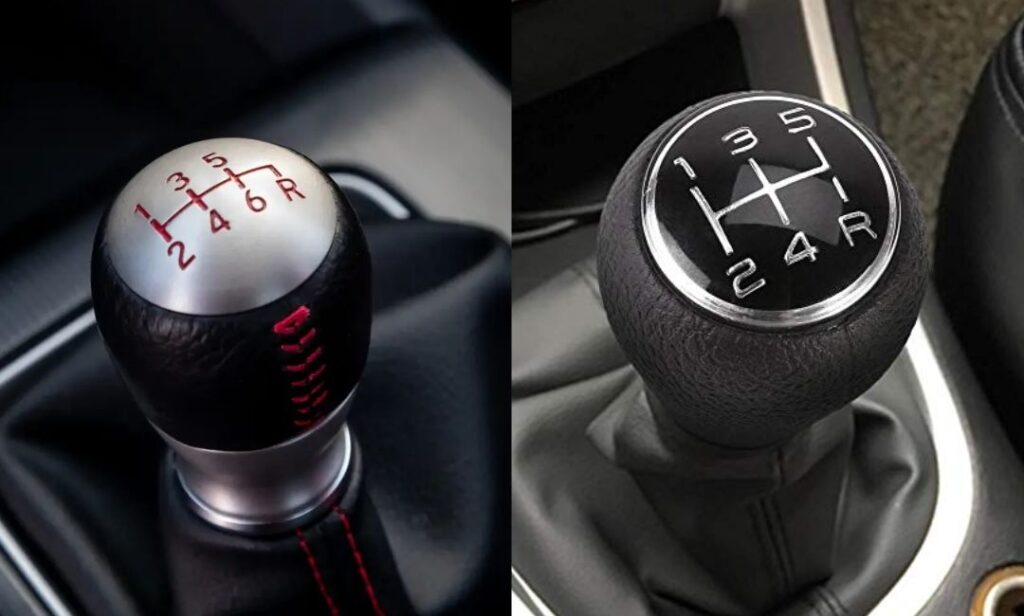
When it comes to comparing a 6-speed manual transmission with its 5-speed counterpart, it’s all about understanding the nuances in gear ratios, performance, and overall driving feel.
Recommendation: 10 Best Mountain Cars to Tackle Steep Roads and Rough Trails
In this section, we break down the core differences that set these two systems apart—from the impact of that extra gear on acceleration and fuel efficiency to how each transmission manages power delivery during spirited driving. Whether you’re curious about engineering details or just wondering how these differences translate to your daily driving experience, this overview will help clarify what each option brings to the table.
1. Number of Gears
One difference that stands out in a 5-speed and a 6-speed manual is the number of gears. While the 5-speed has one less gear, this does not necessarily mean that the difference between the two transmissions is insignificant; in fact, it can often be noticed how the car drives, how fuel efficient it is, and how smooth it goes on the road.
- 5-Speed Transmission: True to its name, it has five gears to shift between. This is mostly common in older or smaller cars.
- 6-Speed Transmission: It has six gears and somewhat offers you extra options for shifting and fine-tuning your engine, especially when used at faster speeds.
2. Fuel Efficiency
There’s always fuel economy on a driver’s mind, and the transmission plays a significant role in the efficiency of the car’s usage of fuel.
- 5-Speed: Generally, 5-speed will be more fuel-efficient at low speeds or during city driving, as it isn’t working hard to change gears.
- 6-speed: 6-speed manual is often fuel-efficient at high highway speeds, especially when your engine runs with fewer revolutions per minute. So, it makes it more likely to save gasoline when driving far.
3. Engine RPM (Revolution Per Minute)
The RPMs are an indicator of how hard your engine is working at any point in time. Generally, the lower the RPMs, the less engine stress and better fuel economy.
- 5-Speed Transmission: A 5-speed needs the engine to work harder in order to keep pace at higher speeds. Higher RPMs result from this action and will reduce both fuel economy and the wear and tear on your engine in the long run.
- 6-Speed Transmission: The engine here will have the capability to cruise at relatively low RPMs, especially over long highway drives, for more efficient travel.
4. Performance and Driving Experience
If you are performance-oriented, the 6-speed manual transmission gives you an edge.
- 5-Speed: A 5-speed is fine for driving around town and gets the job done, but a little “under-geared” at higher speeds, where you feel you are shifting more often than necessary to accelerate from a stop.
- 6-Speed: The 6-speed transmission is the favorite of performance enthusiasts as it allows for smoother shifts, better acceleration, and general control over the engine. This extra gear will enable you to pick the right power band, either accelerating or cruising.
5. Cost and Availability
As for performance, the 6-speed transmission gives a better result so that it can come at a higher cost than the other one.
- 5-Speed Transmission: Cars with 5-speed manuals are mostly affordable. As they are common in older and smaller models, their cost can be lower than a 6-speed manual.
- 6-Speed Transmission: Cars with 6-speed manuals come with powerful performance and better fuel efficiency. So, it generally has a higher cost.
| Factor | 5-Speed Manual | 6-Speed Manual |
| Number of Gears | Five gears; more common in older, smaller cars. | Six gears; more shifting can be done especially at higher RPM |
| Fuel Efficiency | Better at low-speed operations, city driving. | Better fuel consumption at highway speed due to a lower RPM. |
| Engine RPM | More prone to engine stress in RPM at high speed. | Low RPM at high speed reduces tear and wear; improves efficiency. |
| Performance | Good for city travels but feels way under-geared when traveling at high speeds. | Smoother shift; better acceleration; more control. |
| Cost and availability | Less expensive; mainly found in older smaller models. | Higher Price; For better performance and efficiency. |
6 Top Picks of 5-Speed and 6-Speed Manual Cars
If you’re a stick shift lover, 2025 is a good year to keep the feel alive as automatics and EVs begin to dominate. A few models still allow the driver to row through the gears itself.
Whether you are in need of an affordable commuter or some high-performance thrill, these six manual cars provide the right mix of fun and control. Let’s take a look at the best picks of the day that still pack a clutch pedal.
1. 2025 Acura Integra (6-Speed Manual)
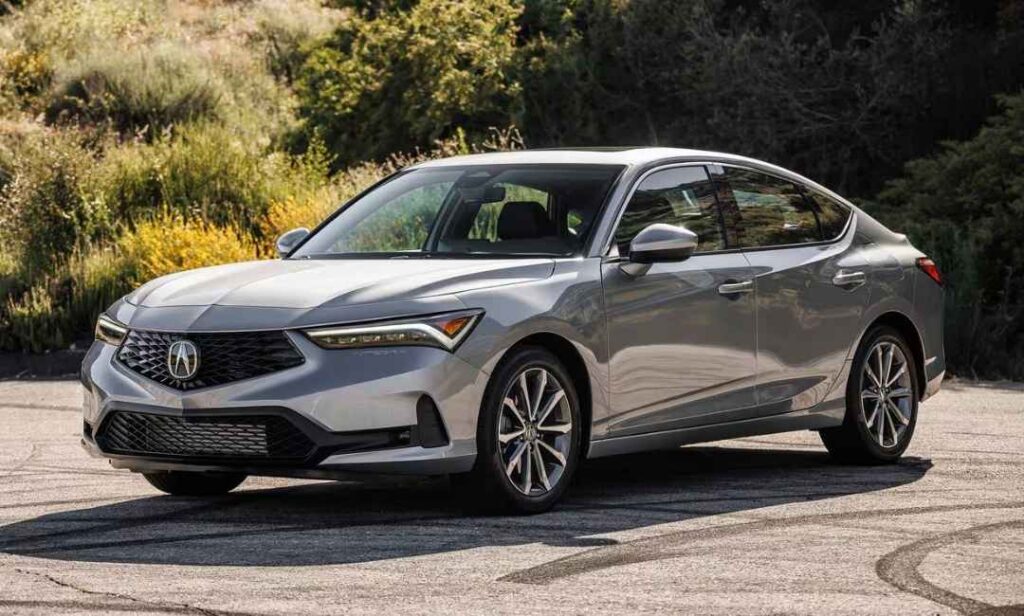
There’s still life in the manual driving experience, as embodied by the latest Acura Integra, with its silky 6-speed transmission. Meant for the enthusiast, it promises crisp, smooth shifts at the very lightest of clutches so that every drive will be sporty and involving. Ideal for anyone who likes to be completely in control of how they are driven.
2. 2025 BMW M2 (6-Speed Manual)

The 6-speed manual for the BMW M2 will be a true purist’s dream. There’s no shortage of drive pleasure here with tight, crisp shifting and rear-wheel drive dynamics to the delight of driver and machine. It brings out the very best on twisting roads and, of course, the track.
3. 2025 Chevrolet Spark (5-Speed Manual)
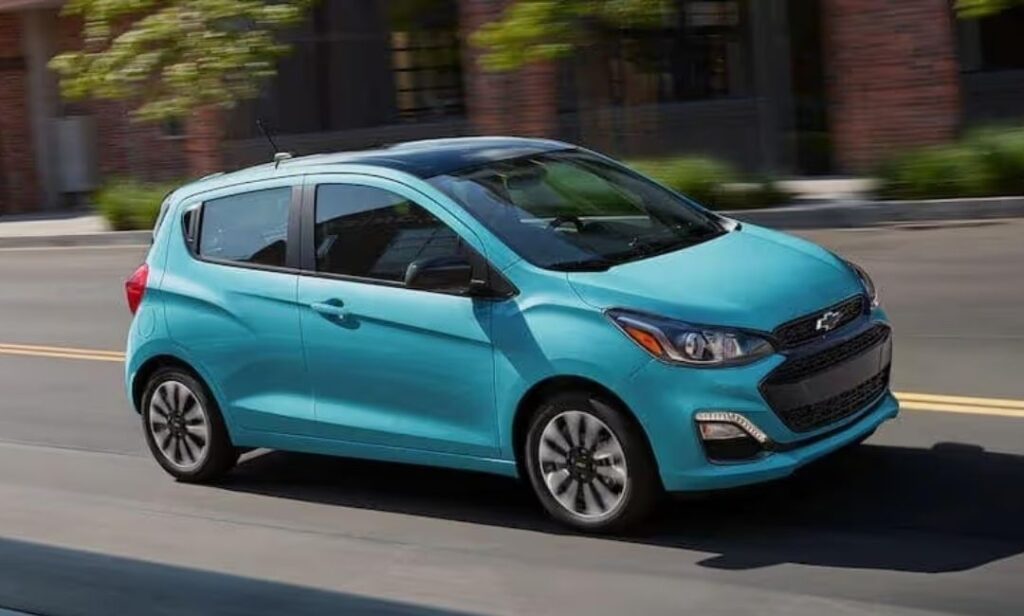
The cheapest manual that stands out, the Chevy Spark, is one of the last small cars with a 5-speed on. It is easy to drive and fuel-efficient, and it offers a real unchanged manual shifting experience in the city and for first-time manual drivers.
4. 2025 Cadillac CT4-V Blackwing (6-Speed Manual)
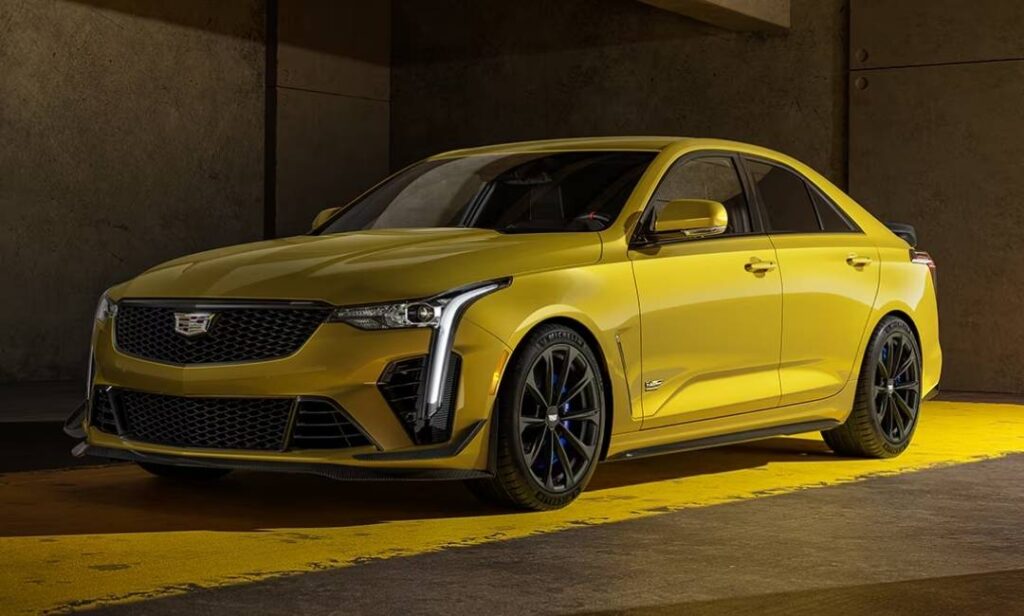
A true performance sedan, the CT4-V Blackwing offers a good old-fashioned muscle feel with its standard 6-speed manual transmission. Short gear throws and rev-matching technology ensure smooth power shifts that make for an engaging driving experience.
Recommendation: How To Get Approved For $500 Down Cars with No Credit Check?
5. 2025 Ford Mustang (6-Speed Manual)

The latest Ford Mustang remains so beautifully classic, still only a 6-speed manual transmission. Drivers will experience some raw muscle-car experience through such a car with high-performance tuning, smooth clutch engagement, and a very durable gearbox-making a great ride through burnouts or backroads thrill.
6. 2024 Nissan Versa (5-Speed Manual)

One of the least expensive manual transmission cars, the Nissan Versa only comes with a 5-speed transmission. Its design is mainly for smooth, easy shifts and good fuel-efficiency commuting. It isn’t the most sporty vehicle out there, but those who want simple and reliable shifting will appreciate what this car has to offer.
Related FAQ’s
More solid advantages of getting a 6-speed manual transmission are that you get better acceleration, more power at different speeds, and a really smooth highway drive. Even the comfort of less engine strain, quieter cruising, and improved fuel efficiency make it an excellent choice both for performance and for being used in heavy-duty traffic.
There’s a different amount of power to be delivered to your engine via each gear. The most power for pulling and getting your car moving is from first gear, but on the other hand, higher gears, such as fifth or sixth gear, offer the least pulling force but let your car reach even higher speeds at highway conditions to conserve fuel.
In conclusion, manual transmissions allow you to have true control over your ride. 6 speed manual vs 5 speed manual transmission exploration showcases how these two popular types offer entirely different driving experiences within the same vehicle.
5-Speed is simple, cheap, and ideal for city driving as it does not put too much strain on your engine and provides better mileage. Whereas the 6-Speed variant is superior, offering better fuel efficiency, smoother performance, and more control on the higher end of the RPM scale. The great thing is that no matter which type you choose, you are going to experience enhanced handling and superior driving dynamics.


